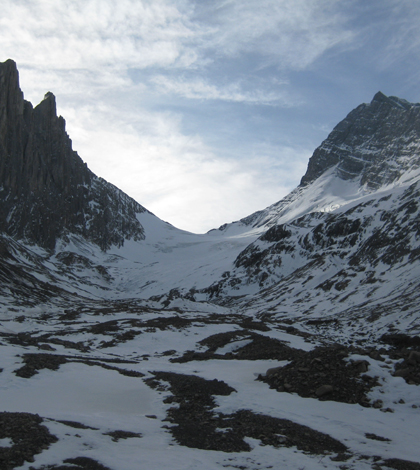Shearing Processes Help Sustain Glacial Ice Microbes

Robertson Glacier near Canmore, Alberta, in 2013. Research by Montana State professors and others has found that the grinding action of glacial ice sheets against silicate rocks, when combined with water, releases enough hydrogen gas to sustain microorganisms that produce methane. (Credit: Mark Skidmore / Montana State University)
For more than a decade, scientists have known microbes can live under glacial ice sheets that are millions of years old, but the mechanism that allows the starved microbes to obtain energy for survival has been a mystery.
Now, research by Montana State University professors and others appearing in the November 2015 issue of Nature Geoscience has found that the grinding action of glaciers and ice sheets against silicate rocks, when combined with water, releases enough hydrogen gas to sustain microorganisms that produce methane.
This is the first time that such a mechanism has been considered in a glaciated environment, scientists say. They note that it’s an important mechanism for supporting life in any subsurface system and add that it likely extends to numerous other wet environments where seismic activity or other physical processes lead to shearing of silicate minerals.
As part of the research, Montana State University researchers collected a rock sample from Robertson Glacier near Canmore, Alberta, and sent the samples to scientists at the University of Bristol. Researchers there crushed the sample, along with subglacial rock samples from Greenland, Norway and Antarctica, in a lab.
The samples were ground into progressively smaller pieces to replicate the physical process of an ice sheet moving against bedrock. During the grinding process, surface minerals were sheared and free radicals formed. When researchers added water to the sample, hydrogen gas was produced, enough to support subglacial microbial communities. The amount of hydrogen produced increased with higher temperatures and with increased surface area of the crushed rock.
The hydrogen-generating mechanism is an important process for microbes existing under ice sheets for extended periods of time, the researchers say. Initially, subglacial microbes can obtain organic carbon from soils or vegetation that are overrun as an ice mass forms, but eventually these organic carbon energy sources become depleted. Once they’re exhausted, the availability of hydrogen becomes key to the survival of the microbes.
Environments where these conditions exist include East Antarctica, which has been covered in ice for millions of years. But there are other portions of the Earth, clearly, that have been glaciated throughout our planet’s history. Most continents, in fact, have been covered in ice at some time.
Scientists from NASA are also interested in utilizing the results of the research. They are intrigued by the extremes that life forms on Earth resort to in surviving. Such analysis of extreme highs and lows in temperatures may also aid understanding of other planets within our solar system, like Mars.
There are silicate rocks on Mars, and also ice caps and glacier-like features, so there’s no reason to believe why ice on Mars grinding up silicate rocks shouldn’t interact with melt water to produce hydrogen there exactly as it does on Earth, scientists say.
Future research building upon the findings published in Nature Geoscience will likely focus on how hydrogen-dependent primary producers support more complex forms of life underneath glaciers. The next step, researchers say, is to figure out the extent to which hydrogen produced by silicate mineral shearing is supporting other forms of life in subglacial ecosystems.
Funding for the work was provided by NASA. Other institutions that assisted include the University of Cincinnati, the British Antarctic Survey, the Norwegian Water Resources & Energy Directorate and Carl Zeiss Microscopy, Ltd.
Top image: Robertson Glacier near Canmore, Alberta, in 2013. Research by Montana State professors and others has found that the grinding action of glacial ice sheets against silicate rocks, when combined with water, releases enough hydrogen gas to sustain microorganisms that produce methane. (Credit: Mark Skidmore / Montana State University)




0 comments